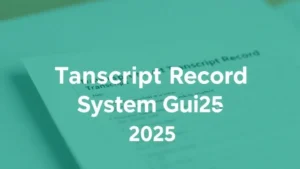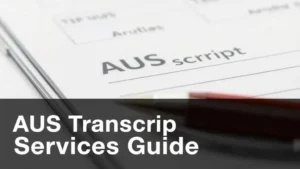Student Transcript Services Guide 2025
Tracking down your student transcript can feel like searching for a needle in a haystack. Did you know electronic transcripts can be delivered within 24 hours, compared to up to 7 business days for print requests? Johnson & Wales University. You’ve come to the right place.
Here’s the thing: this guide promises to demystify the entire transcript process—from defining what a student transcript is to navigating your institution’s online ordering system. You’ll learn insider tips on fees, FERPA compliance, delivery methods, and even advanced hacks to speed things up.
Next, we’ll preview the main points: what each academic record entails, why transcripts matter for careers and applications, step-by-step requesting instructions, delivery options, common mistakes to avoid, and emerging trends for 2025. Let’s dive in.
Table of Contents
What is a Student Transcript?
Ever wondered why this simple document holds so much power? A student transcript is the official record of your academic journey, detailing every course, grade, credit hour and milestone from day one.
Unlike an unofficial copy you might view online, an official transcript is signed or sealed by your registrar and recognized by employers, graduate schools, and professional boards. It often includes:
- All courses attempted, including withdrawals and repeats
- Grade point averages (GPA) by term and cumulative
- Transfer credits and study abroad notations
- Degree conferred dates (if applicable)
For example, when Maya applied to a master’s program, she included her official transcript to showcase her 3.8 GPA and study abroad credits from her junior year. That transparency helped admissions verify credentials quickly.
“Our mission is to minimize barriers for students by ensuring the integrity of academic records and policies, facilitating easy access to transcripts while maintaining strict privacy standards.” – Registrar Sheilah Sites, Concord University
Actionable takeaway: Request an unofficial transcript first to check for errors before ordering the official one.
Why Student Transcripts Matter
You might be wondering why this single document is so critical. Simply put, your transcript is the fingerprint of your academic story.
In other words, it:
- Proves your qualifications to employers
- Serves as a foundation for graduate or professional school applications
- Validates prerequisites for certifications or licensure
- Confirms eligibility for scholarships or financial aid audits
Interestingly enough, 85% of top employers verify academic credentials before extending offers. When your transcript is accurate and up-to-date, you eliminate delays and build credibility.
How to Request Your Student Transcript
Ready to order? Follow these steps (and skip the frustration).
- Visit your institution’s registrar portal. Official Transcript Request Guide 2025
- Log in securely with your student credentials.
- Choose official or unofficial, delivery method, and recipient.
- Confirm fees, shipping details, and processing times.
- Submit the request and save the confirmation number.
In many cases, you can track your order in real time. That said, some schools still require paper forms—so double-check your institution’s specific process. Need faster delivery? Look for express courier options at checkout.
“Offering electronic transcripts with delivery in less than 24 hours meets the modern student’s need for speed and convenience without compromising security.” – Registrar Office, Johnson & Wales University
Actionable takeaway: Keep your login info handy and verify your mailing address before submitting.
Delivery Methods: Electronic vs Print
What’s the best way to send your transcript? Here’s the lowdown.
Electronic delivery, often as a secure PDF, is:
- Fast—24 hours or less
- Trackable with real-time status updates
- Cost-effective (usually lower fees than print)
Print transcripts arrive via mail or courier. They’re:
- Recognized by organizations that don’t accept digital versions
- Sealed to prevent tampering
- Slower—up to 7 business days (plus shipping)
In other words, choose electronic if speed and convenience matter; go print if your recipient insists on a sealed paper copy.
For more on digital options, see Official Transcript Request Guide 2025.
Fees, Processing Times, and FERPA Compliance
Worried about hidden costs? Let’s break it down.
- Base fee: ~$7.50 per official transcript (additional for express delivery).
- Electronic transcript: Often an extra $2–3 per copy.
- Certified mail or courier: $10–$20 extra.
- Processing time: Electronic in 24 hours; print in 3–7 business days.
Under FERPA, you must consent before your transcript is released. Institutions may require signed forms or an electronic signature during checkout.
Case in point: When Alex needed transcripts for a job board audit, he consented online and tracked each copy via mobile text alerts. No guesswork involved.
Actionable takeaway: Review all fees upfront and keep a record of your consent documentation.
Advanced Tips and Common Mistakes
Ready to take it a step further? Here are pro-level strategies:
- Integrate transcript data with academic advising tools like DegreeWorks to monitor progress in real time.
- Verify transfer credit details before requesting official documents to avoid delays.
- Use batch services from National Student Clearinghouse for multiple recipients.
Pro tip: Military personnel can leverage the Joint Service Transcript service for seamless credit transfers.
Future Trends in Transcript Services
The way we share transcripts is evolving—fast. In 2025, expect:
- Wider use of blockchain for tamper-proof records
- API integrations with employers and licensing boards
- Mobile apps offering instant order status notifications
- Enhanced privacy controls beyond FERPA
Get ready for even more automation in your academic workflow.
FAQs
- How long does it take to get an electronic transcript?
- Most institutions process electronic transcripts within 24 hours, plus delivery time.
- Can I cancel a transcript request?
- Often yes, but you’ll need to contact your registrar immediately to avoid fees.
- What if there’s an error on my transcript?
- Request an unofficial copy first. If you spot mistakes, file a grade appeal or record correction before ordering the official version.
- Do international universities accept electronic transcripts?
- Many do, but check with each institution. Some require hard copies or apostille certification.
Conclusion
By now, you’ve got a clear roadmap to obtain your student transcript without the usual headaches. Remember to verify your info, choose the right delivery method, and comply with FERPA requirements.
Next steps:
- Check your unofficial transcript for accuracy.
- Submit your official transcript request via your registrar’s portal.
- Track delivery status and confirm receipt.
Armed with this guide, you’re ready to tackle any transcript challenge in 2025. Good luck—and may your records always reflect your best work.





